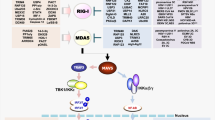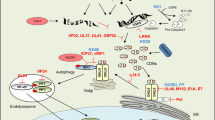Abstract
The innate immune system senses infection by detecting either evolutionarily conserved molecules essential for the survival of microbes or the abnormal location of molecules. Here we demonstrate the existence of a previously unknown innate detection mechanism induced by fusion between viral envelopes and target cells. Virus-cell fusion specifically stimulated a type I interferon response with expression of interferon-stimulated genes, in vivo recruitment of leukocytes and potentiation of signaling via Toll-like receptor 7 (TLR7) and TLR9. The fusion-dependent response was dependent on the stimulator of interferon genes STING but was independent of DNA, RNA and viral capsid. We suggest that membrane fusion is sensed as a danger signal with potential implications for defense against enveloped viruses and various conditions of giant-cell formation.
This is a preview of subscription content, access via your institution
Access options
Subscribe to this journal
Receive 12 print issues and online access
$209.00 per year
only $17.42 per issue
Buy this article
- Purchase on Springer Link
- Instant access to full article PDF
Prices may be subject to local taxes which are calculated during checkout





Similar content being viewed by others
References
Paludan, S.R., Bowie, A.G., Horan, K.A. & Fitzgerald, K.A. Recognition of herpesviruses by the innate immune system. Nat. Rev. Immunol. 11, 143–154 (2011).
Brennan, K. & Bowie, A.G. Activation of host pattern recognition receptors by viruses. Curr. Opin. Microbiol. 13, 503–507 (2010).
Ishikawa, H., Ma, Z. & Barber, G.N. STING regulates intracellular DNA-mediated, type I interferon-dependent innate immunity. Nature 461, 788–792 (2009).
Ishikawa, H. & Barber, G.N. STING is an endoplasmic reticulum adaptor that facilitates innate immune signalling. Nature 455, 674–678 (2008).
Sadler, A.J. & Williams, B.R. Interferon-inducible antiviral effectors. Nat. Rev. Immunol. 8, 559–568 (2008).
Orvedahl, A. et al. Autophagy protects against Sindbis virus infection of the central nervous system. Cell Host Microbe 7, 115–127 (2010).
Ichinohe, T., Lee, H.K., Ogura, Y., Flavell, R. & Iwasaki, A. Inflammasome recognition of influenza virus is essential for adaptive immune responses. J. Exp. Med. 206, 79–87 (2009).
Noyce, R.S. et al. Membrane perturbation elicits an IRF3-dependent, interferon-independent antiviral response. J. Virol. 85, 10926–10931 (2011).
Roberts, A.P. et al. Differing roles of inner tegument proteins pUL36 and pUL37 during entry of herpes simplex virus type 1. J. Virol. 83, 105–116 (2009).
Dargan, D.J., Patel, A.H. & Subak-Sharpe, J.H. PREPs: herpes simplex virus type 1-specific particles produced by infected cells when viral DNA replication is blocked. J. Virol. 69, 4924–4932 (1995).
Unterholzner, L. et al. IFI16 is an innate immune sensor for intracellular DNA. Nat. Immunol. 11, 997–1004 (2010).
Zhang, Z. et al. The helicase DDX41 senses intracellular DNA mediated by the adaptor STING in dendritic cells. Nat. Immunol. 12, 959–965 (2011).
Hornung, V. et al. AIM2 recognizes cytosolic dsDNA and forms a caspase-1-activating inflammasome with ASC. Nature 458, 514–518 (2009).
Janeway, C.A. Jr. Approaching the asymptote? Evolution and revolution in immunology. Cold Spring Harb. Symp. Quant. Biol. 54, 1–13 (1989).
Kawai, T. & Akira, S. Toll-like receptors and their crosstalk with other innate receptors in infection and immunity. Immunity 34, 637–650 (2011).
Szilágyi, J.F. & Cunningham, C. Identification and characterization of a novel non-infectious herpes simplex virus-related particle. J. Gen. Virol. 72, 661–668 (1991).
Roche, M. et al. HIV-1 escape from the CCR5 antagonist maraviroc associated with an altered and less-efficient mechanism of gp120–CCR5 engagement that attenuates macrophage tropism. J. Virol. 85, 4330–4342 (2011).
Tanaka, T. et al. DiC14-amidine cationic liposomes stimulate myeloid dendritic cells through Toll-like receptor 4. Eur. J. Immunol. 38, 1351–1357 (2008).
Csiszár, A. et al. Novel Fusogenic liposomes for fluorescent cell labeling and membrane modification. Bioconjug. Chem. 21, 537–543 (2010).
Sun, Y. et al. TLR4 and TLR5 on corneal macrophages regulate Pseudomonas aeruginosa keratitis by signaling through MyD88-dependent and -independent pathways. J. Immunol. 185, 4272–4283 (2010).
Cheshenko, N. et al. Herpes simplex virus triggers activation of calcium-signaling pathways. J. Cell Biol. 163, 283–293 (2003).
Gonzalez-Dosal, R. et al. HSV infection induces production of ROS, which potentiate signaling from pattern recognition receptors: role of S-glutathionylation of TRAF3 and 6. PloS Pathogen 7, e1002250 (2011).
Murthy, M., Teodoro, R.O., Miller, T.P. & Schwarz, T.L. Sec5, a member of the exocyst complex, mediates Drosophila embryo cellularization. Development 137, 2773–2783 (2010).
Dong, B. et al. Phospholipid scramblase 1 potentiates the antiviral activity of interferon. J. Virol. 78, 8983–8993 (2004).
Smith-Garvin, J.E., Koretzky, G.A. & Jordan, M.S. T cell activation. Annu. Rev. Immunol. 27, 591–619 (2009).
Alon, R. & Shulman, Z. Chemokine triggered integrin activation and actin remodeling events guiding lymphocyte migration across vascular barriers. Exp. Cell Res. 317, 632–641 (2011).
Tiwari, V. & Shukla, D. Phosphoinositide 3 kinase signalling may affect multiple steps during herpes simplex virus type-1 entry. J. Gen. Virol. 91, 3002–3009 (2010).
Li, E., Stupack, D., Klemke, R., Cheresh, D.A. & Nemerow, G.R. Adenovirus endocytosis via αv integrins requires phosphoinositide-3-OH kinase. J. Virol. 72, 2055–2061 (1998).
Saeed, M.F., Kolokoltsov, A.A., Freiberg, A.N., Holbrook, M.R. & Davey, R.A. Phosphoinositide-3 kinase-Akt pathway controls cellular entry of Ebola virus. PLoS Pathog. 4, e1000141 (2008).
Herschke, F. et al. Cell-cell fusion induced by measles virus amplifies the type I interferon response. J. Virol. 81, 12859–12871 (2007).
Nordborg, C., Larsson, K., Aman, P. & Nordborg, E. Expression of the class I interferon-related MxA protein in temporal arteries in polymyalgia rheumatica and temporal arteritis. Scand. J. Rheumatol. 38, 144–148 (2009).
Sharma, S. et al. Innate immune recognition of an AT-rich stem-loop DNA motif in the Plasmodium falciparum genome. Immunity 35, 194–207 (2011).
Acknowledgements
We thank A.R. Thomsen (Copenhagen University) for mice deficient in the receptor for type I interferon (Ifnar1−/− mice); J. Sodroski (Dana Farber Cancer Institute) for the pSVIII-ADA Env plasmid (obtained via P. Gorry); and P. Gorry (Burnet Institute) for the fusion-deficient construct pSVIII-ADA Y552F. Supported by The Danish Medical Research Council (09-072636 and 10-081986), The Novo Nordisk Foundation, The Velux Foundation, Christian d. Tiendes Fond, Aase og Ejnar Danielsens Fond, Fhv. Direktør Leo Nielsen og hustru Karen Margrethe Nielsen's legat for Lægevidenskabelig Grundforskning, The Lundbeck Foundation (R17-A1526 and R34-3855), Elvira og Rasmus Riisforts almenvelgørende Fond, Aarhus University Research Foundation, Kathrine og Vigo Skovgaards Fond, the US National Institutes of Health (AI061679 to B.C.H., and AI083713 and AI067497 to K.A.F.), the Faculty of Health Sciences of Aarhus Univeristy (S.B.J. and S.B.R.), the European Union Seventh Framework Programme Marie Curie Action (K.A.H.) and the UK Medical Research Council (F.J.R.).
Author information
Authors and Affiliations
Contributions
C.K.H., K.A.F. and S.R.P. conceived of the project; C.K.H. designed the experimental setup, organized the project, did most of the experiments, drafted the manuscript and, together with S.R.P. and K.A.F. edited and finalized the manuscript; S.B.J., M.R.J., K.A.H., M.H.C., R.G.-D., S.B.R., H.B.M. and N.C. did experiments; S.R.P., K.A.F. and B.C.H. supervised experiments; and F.J.R. and T.O.Y. provided reagents.
Corresponding author
Ethics declarations
Competing interests
The authors declare no competing financial interests.
Supplementary information
Supplementary Text and Figures
Supplementary Figures 1–8 (PDF 930 kb)
Rights and permissions
About this article
Cite this article
Holm, C., Jensen, S., Jakobsen, M. et al. Virus-cell fusion as a trigger of innate immunity dependent on the adaptor STING. Nat Immunol 13, 737–743 (2012). https://doi.org/10.1038/ni.2350
Received:
Accepted:
Published:
Issue Date:
DOI: https://doi.org/10.1038/ni.2350
This article is cited by
-
ESCRT-dependent STING degradation inhibits steady-state and cGAMP-induced signalling
Nature Communications (2023)
-
Cell fusion upregulates PD-L1 expression for evasion from immunosurveillance
Cancer Gene Therapy (2023)
-
Evolution of RNA sensing receptors in birds
Immunogenetics (2022)
-
VRK2 is involved in the innate antiviral response by promoting mitostress-induced mtDNA release
Cellular & Molecular Immunology (2021)
-
Transcriptome sequencing analysis of porcine alveolar macrophages infected with PRRSV strains to elucidate virus pathogenicity and immune evasion strategies
VirusDisease (2021)



